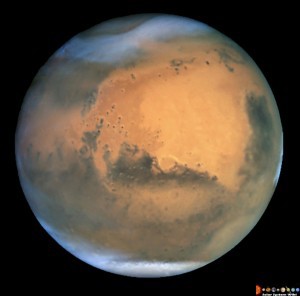Russian physicists have discovered two types of dust in the atmosphere of Mars.
 A group of French and Russian scientists, including three specialists from the laboratory of infrared spectroscopy of high-resolution planetary atmospheres at the Moscow Institute of Physics and Technology (Ph.D., Anna Fedorova, Ph.D. Alexander Rodin, and Ph.D. M. Oleg Korablyov), published in the journal Icarus a scientific work with the results of a large-scale study, during which for the first time the data of the SPICAM infrared and ultraviolet spectrometers of the Mars-Express apparatus were simultaneously analyzed when sounding the atmosphere on the planet limb. As a result, scientists managed to restore the radii and concentration of particles in the atmosphere of Mars at altitudes from 10 to 50 km. The measurements were carried out in the southern and northern hemispheres during the season of northern summer.
A group of French and Russian scientists, including three specialists from the laboratory of infrared spectroscopy of high-resolution planetary atmospheres at the Moscow Institute of Physics and Technology (Ph.D., Anna Fedorova, Ph.D. Alexander Rodin, and Ph.D. M. Oleg Korablyov), published in the journal Icarus a scientific work with the results of a large-scale study, during which for the first time the data of the SPICAM infrared and ultraviolet spectrometers of the Mars-Express apparatus were simultaneously analyzed when sounding the atmosphere on the planet limb. As a result, scientists managed to restore the radii and concentration of particles in the atmosphere of Mars at altitudes from 10 to 50 km. The measurements were carried out in the southern and northern hemispheres during the season of northern summer.The results are interesting. It turns out that the dust in the atmosphere of Mars consists of two fractions, and at an altitude of 40-50 km an aerosol layer was found with a composition not yet defined.
Press release IKI RAS

The illustration shows how the SPICAM spectrometer obtains data on the Martian atmosphere by comparing spectrograms at different heights with the pure spectrogram of the Sun.
')
As it turned out, there are two groups of particles in the Martian atmosphere. The first type of aerosol consists of larger particles of water ice (average radius 1.2 microns) and dust (0.7 microns). They are not very many: from 0.01 to 10 particles per cubic centimeter. The second type is dust particles with a radius of several tenths and hundredths of a micrometer, which are much larger: from 1 to 1000 cubic centimeters, depending on the height.
In the northern hemisphere at high latitudes (from 60 degrees) the level of the “large” fraction of the aerosol reaches altitudes of 30 km, in the middle it rises to 40–50 km, and above 20 km it is mainly water ice, and below it is dust. The radii of the particles are about 0.76 microns (dust) and 1.2 microns (water ice), and the concentration varies between 0.4–2 and 0.01–0.3 particles per cubic cm, respectively.
“Fine” dust is much larger: at an altitude of 10 km, the number reaches 10 thousand particles in cubic cm, and by 30–35 km - 100 particles in the same volume. Its average size increases from pole to equator: 0.039 microns at latitudes higher than 60 degrees and 0.048 microns below (average value 0.044 microns).
In the southern hemisphere, as is known from other observations, the atmosphere as a whole is fairly clean. The average size of large dust particles at latitudes above 50 degrees was 0.75 microns, and the number in cubic centimeter varies from 0.1 to 2. Water ice particles are larger — the radius is approximately 0.86 microns, while the concentration varies from 0.005 to 0 , 05 in cubic cm. The average radius of fine dust is larger than in the north: 0.07 μm - and the concentration drops from a height of 100 (by 35 km) to 0.6 particles (by 70 km) in cubic cm. At low latitudes the sky is almost clear and the aerosol concentration is low.
It is interesting, however, that in this region, at altitudes of 40–50 km in the ultraviolet range, an aerosol layer was found with a composition that is not yet determined. If it is dust, then the particles are very small (0.06 µm), and their number in cubic centimeters is very large - from 100 to 3000. In the case of water ice particles, their size will be somewhat larger, and the concentration, on the contrary, will be smaller. The existence of this layer may be due to the global flow of warm air masses from the northern (summer) hemisphere to the southern, where they are cooled and descended (the so-called Headley cell). Such a circulation is characteristic of the season close to the solstice in both hemispheres.
From the RAS press release
The concentration of particles in the Martian atmosphere is not high. By earthly standards, this is a clean atmosphere. Even in the most "dusty" areas of Mars, the concentration of particles is less than in the air of a regular room, until a dust storm begins.
It is curious what role aerosols play in the climate system of Mars. The fact is that the composition of particles in the atmosphere described above cannot exist for a long time. Obviously, it is replenished from the outside. The source of new particles can be dust from the surface of the planet.
The current climate of Mars is interesting in itself, because it is the only planet among the Earth group with a condensed atmosphere, and the climate system is largely controlled by aerosol. In addition, the planet may have experienced a catastrophic climate change and retained traces of the climate of the past era, scientists from MIPT suggest.
Source: https://habr.com/ru/post/227471/
All Articles